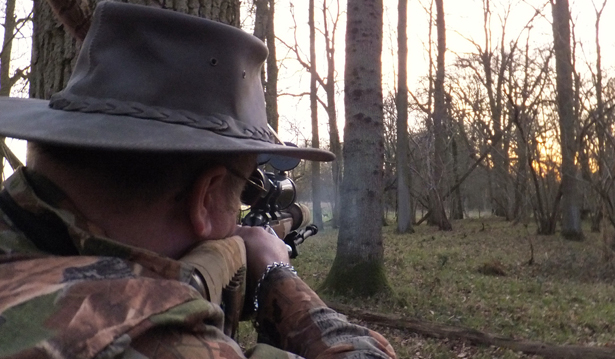What to expect from your Deer Stalking during the month of March.
Traditionally March was a closed season for many species of deer however with the rise in deer numbers over the last few decades legislation has been introduced to allow stalking of the female of the species for an additional month.

(Colin takes a shot at a distant Roe Doe, the photo is taken at the exact moment the shot is fired observable from the blast seen around the muzzle).
Whilst shooting heavily pregnant females is distasteful we must remember that we have a job to do and that March was given open status in order to allow us an opportunity to get that job done. I have already written at length in a previous blog "Doe Culling in March" about this subject and so won't repeat myself suffice to say that I myself have no qualms about stalking this month however do so with an increased consideration of my responsibilities to our noble quarry, and I say this for the following reason.
Deer during March are under considerable nutritional stress. This is because during the winter months there is a dire lack of browse available in the woodlands, added to which available grazing is usually of poorer quality. This lack of nutrition over a prolonged period can cause an inability to fight infections and disease. This is particularly so in the young who are often caught in a vicious cycle of starvation and infection which is at its peak during late winter when the highest rates of natural mortality occur. The deer are effectively at their lowest ebb added to which the Does are heavily pregnant. Adding further stress to their already weakened condition by hunting should therefore not be done so lightly.
That said March is for many stalkers and deer managers a busy time as it is considered to be the optimum time to carry out a head count. Whilst this is less easy with Fallow who by their nature roam from place to place it is a great time to gauge approximate numbers of Roe deer. During the early part of March Roe remain non territorial and continue to tolerate each other's presence. As a result and due also to the afore mentioned lack of browse in the woods large family groups of Roe can be seen grazing openly in the fields.
Of course many young does and weaker bucks will be pushed out once the territorial activity resumes toward the end of March and into April, however it is in March that it is possible to, at the very least, gauge the trend in numbers that you are seeing in comparison to the previous year. It is also an excellent time to start sizing up your Roe Buck ready for the start of the Roe Buck season in April. Remember however that antler's appear a lot larger in velvet than they do in hard antler so don't get too excited!
At County Deer Stalking we also use March as an opportunity to shake up our routine. Deer can get very accustomed to the times that we stalk, usually evenings and early mornings, and so with the deer being seen more regularly in the fields and the weather more moderate March offers us the novelty of conducting stalking outings in the middle of the day.
With all these agendas to consider I love March. Being in the woods as the days start to lengthen and the woods start to come alive again is a privilege. Added to this the ability to watch otherwise secretive Roe deer soaking up the first warmth of spring sunshine in the open fields is a joy. We can feel in the air that spring is just around the corner and the deer have just a little longer to endure before they can start recovering from the winter cold and famine.
IN Season in England & Wales: Roe Does, Fallow Does & Fallow Buck, Sika Stags & Sika Hinds, Red Stags & Red Hinds, CWD Bucks & CWD Does, Muntjac Buck & Muntjac Does.
Off Season in England & Wales: Roe Buck.


















